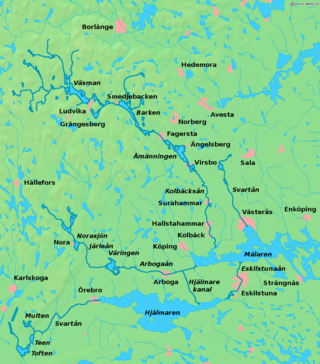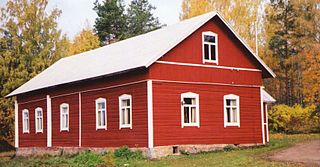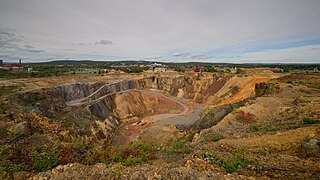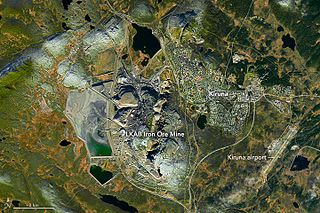
Bergslagen is a historical, cultural, and linguistic region located north of Lake Mälaren in northern Svealand, Sweden, traditionally known as a mining district. In Bergslagen, the mining and metallurgic industries have been important since the Middle Ages although Malmfälten, the mining district of northernmost Sweden centred at the towns of Kiruna and Malmberget, has been of greater importance during the 20th century.

Falu red or falun red is a permeable red paint commonly used on wooden cottages and barns in Sweden, Finland, and Norway.
Luossavaara-Kiirunavaara Aktiebolag (LKAB) is a state owned Swedish mining company. The company mines iron ore at Kiruna and at Malmberget in northern Sweden. The company was established in 1890, and has been 100% state-owned since the 1950s. The iron ore is processed to pellets and sinter fines, which are transported by Iore trains (Malmbanan) to the harbours at Narvik and Luleå and to the steelmill at Luleå (SSAB). Their production is sold throughout much of the world, with the principal markets being European steel mills, as well as North Africa, the Middle East and Southeast Asia. LKAB's mines supply at least 80% of Europe's iron ore.
Boliden AB is a Swedish multinational metals, mining, and smelting company headquartered in Stockholm. The company produces zinc, copper, lead, nickel, silver, and gold, with operations in Sweden, Finland, Norway, and Ireland.

Mining in Australia has long been a significant primary sector industry and contributor to the Australian economy by providing export income, royalty payments and employment. Historically, mining booms have also encouraged population growth via immigration to Australia, particularly the gold rushes of the 1850s. Many different ores, gems and minerals have been mined in the past and a wide variety are still mined throughout the country.

Mining in Iran is still under development, yet the country is one of the most important mineral producers in the world, ranked among 15 major mineral-rich countries, holding some 68 types of minerals, 37 billion tonnes of proven reserves and more than 57 billion tonnes of potential reserves worth $770 billion in 2014. Mineral production contributes only 0.6 percent to the country's GDP. Add other mining-related industries and this figure increases to just four percent (2005). Many factors have contributed to this, namely lack of suitable infrastructure, legal barriers, exploration difficulties, and government control.

Romania ranks tenth in the world in terms of the diversity of minerals produced in the country. Around 60 different minerals are currently produced in Romania. The richest mineral deposits in the country are halite.

The mineral industry is one of the main sectors of the Armenian economy and in 2017 accounted for 30.1% of its exports.
The mineral industry of Russia is one of the world's leading mineral industries and accounts for a large percentage of the Commonwealth of Independent States' production of a range of mineral products, including metals, industrial minerals, and mineral fuels. In 2005, Russia ranked among the leading world producers or was a significant producer of a vast range of mineral commodities, including aluminum, arsenic, cement, copper, magnesium compounds and metals, nitrogen, palladium, silicon, nickel and vanadium.

Mining is the biggest contributor to Namibia's economy in terms of revenue. It accounts for 25% of the country's income. Its contribution to the gross domestic product is also very important and makes it one of the largest economic sectors of the country. Namibia produces diamonds, uranium, copper, magnesium, zinc, silver, gold, lead, semi-precious stones and industrial minerals. The majority of revenue comes from diamond mining. In 2014, Namibia was the fourth-largest exporter of non-fuel minerals in Africa.

During the Middle Ages, between the 5th and 16th century AD, Western Europe saw a period of growth in the mining industry. The first important mines were those at Goslar in the Harz mountains, taken into commission in the 10th century. Another notable mining town is Falun in Sweden where copper has been mined since at least the 10th century and possibly even earlier.

Kiirunavaara is a mountain situated in Kiruna Municipality in Norrbotten County, Sweden. It contains one of the largest and richest bodies of iron ore in the world.

Mining in the United Kingdom produces a wide variety of fossil fuels, metals, and industrial minerals due to its complex geology. In 2013, there were over 2,000 active mines, quarries, and offshore drilling sites on the continental land mass of the United Kingdom producing £34bn of minerals and employing 36,000 people.

Falun Mine was a mine in Falun, Sweden, that operated for a millennium from the 10th century to 1992. It produced as much as two-thirds of Europe's copper needs and helped fund many of Sweden's wars in the 17th century. Technological developments at the mine had a profound influence on mining globally for two centuries. The mine is now a museum and in 2001 was designated a UNESCO World Heritage Site.

The Kiruna mine is the largest and most modern underground iron ore mine in the world. The mine is located in Kiruna in Norrbotten County, Lapland, Sweden. The mine is owned by Luossavaara-Kiirunavaara AB (LKAB), a large Swedish mining company. In 2018 the mine produced 26.9 million tonnes of iron ore. The Kiruna mine has an ore body which is 4 km (2.5 mi) long, 80 metres (260 ft) to 120 metres (390 ft) thick and reaching a depth of up to 2 km (1.2 mi). Since mining began at the site in 1898, the mine has produced over 950 million tonnes of ore. As of 2020 the main haulage level is 1365 m below the ore outcrop at Kiirunavaara that existed prior to mining.
The proposed Kallak mine is a, highly controversial, plan to exploit one of the largest unexploited iron ore deposits in Sweden.

Zinc mining is the process by which mineral forms of the metal zinc are extracted from the earth through mining. A zinc mine is a mine that produces zinc minerals in ore as its primary product. Common co-products in zinc ores include minerals of lead and silver. Other mines may produce zinc minerals as a by-product of the production of ores containing more valuable minerals or metals, such as gold, silver or copper. Mined ore is processed, usually on site, to produce one or more metal-rich concentrates, then transported to a zinc smelter for production of zinc metal.
Mining in North Korea is important to the country's economy. North Korea is naturally abundant in metals such as magnesite, zinc, tungsten, and iron; with magnesite resources of 6 billion tonnes, particularly in the North and South Hamgyong Province and Chagang Province. However, often these cannot be mined due to the acute shortage of electricity in the country, as well as the lack of proper tools to mine these materials and an antiquated industrial base. Coal, iron ore, limestone, and magnesite deposits are larger than other mineral commodities. Mining joint ventures with other countries include China, Canada, Egypt, and South Korea.
Beowulf Mining plc is a UK registered Nordic focused exploration and development company listed on the AIM in London and Spotlight in Sweden. The CEO is Kurt Budge. The company was formed in 1988 as Beowulf Gold. Through subsidiaries Jokkmokk Iron Mines AB and Fennoscandian Resources, it is active in developing open-pit mining in Sweden and Finland respectively; its plans to mine for magnetite iron ore at Kallak, west of Jokkmokk in northern Sweden, and for graphite in Heinävesi, Finland, are controversial.

The European mining industry has a long tradition. Although the continent's mining earns for a small share of GDP, it provides a large and significant share of the world-wide production.















